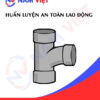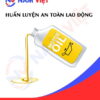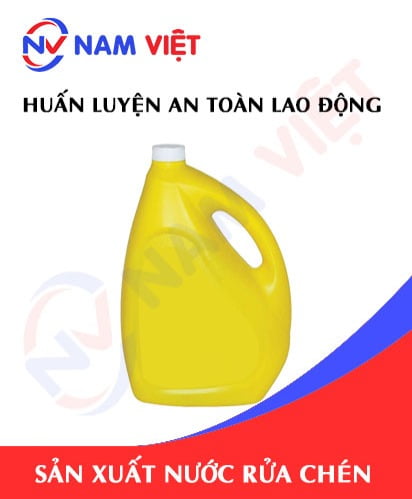Occupational Safety Training for Bread Manufacturing
99,000 ₫
Note: The above price is calculated for one person, the price may fluctuate depending on the number of trainees participating in the course and the market movement. For more accurate price support, please refer to the price list or contact our consulting staff directly.
Occupational safety is an important issue in factory manufacturing bread and needs to be addressed promptly to ensure the health and safety of workers, enhancing the reputation of businesses. The Occupational Safety Training course is one of the effective solutions to raise awareness of how to prevent occupational accidents for workers participating in bread manufacturing.
Table of Contents
Toggle1. Overview of Bread
a. What is bread?
- Bread is a popular type of pastry worldwide, originating from France. Bread is made by combining ingredients with wheat flour, baked in an oven or roasted, sautéed, or fried in a pan. Bread is often sliced thinly and used to make sandwiches, hot bread, or eaten with other foods. There are many types of bread depending on the method and ingredients used, such as traditional French bread, Vietnamese bread, American bread, Italian bread, etc.
- According to the Ministry of Industry and Trade, the national bread consumption reaches about 4.5 million tons per year, with an average growth rate of 10% annually.
- The bread manufacturing industry in Vietnam is also focusing on improving production technology, applying modern technology and automation in the production process to enhance product quality, increase productivity, and reduce production costs.

b. Bread production machinery
There are various types of machinery used in bread production from raw materials to the finished product. Some of the bread production machinery include:
- Dough mixer: used to mix necessary ingredients to create dough, such as flour, water, salt, sugar, and yeast.
- Dough cutter: after mixing, the dough is placed into a dough cutter to divide it into smaller pieces for bread production.
- Dough shaper: the cut dough is shaped into round, flat, or diamond-shaped portions in preparation for baking.
- Bread oven: shaped dough pieces are baked in an oven at appropriate temperature and time.
- Cream injector: if the bread has a cream filling, the cream injector is used to fill the bread.
- Bread packaging machine: after baking and completing production stages, bread is packaged for retail and distribution.
Depending on production scale and technology, bread businesses will choose suitable machinery for their production process.
c. Notable bread manufacturing companies
Notable bread manufacturers in Vietnam include:
- Kinh Do – Thien Long Group: The largest bread manufacturer in Vietnam with over 80% market share. Kinh Do owns famous bread brands such as Givral, Han Ngoc Duc, ABC, Minh Hien.
- Ngon Moi Ngay: Established in 2008, Ngon Moi Ngay quickly became a popular bread brand in Vietnam.
- Banhmi Hanoi: A famous specialty bread brand in Hanoi, made from high-quality ingredients and hand-prepared to ensure quality.
- Banh Mi Sai Gon: Established in 1958, one of the oldest and most famous bread brands in Vietnam.
- Banh Mi Phuong: A renowned specialty bread brand from Hoi An, highly rated for quality and flavor.

d. Specific roles in a bread manufacturing factory
Group 1
- Executive director, deputy executive director, department heads in the bread manufacturing factory.
Group 2
- Safety officers: manage safety in the factory, design safety procedures, supervise and ensure employees follow safe working practices.
Group 3
- Ingredient preparation: the most important stage in bread production, including weighing and mixing flour, water, yeast, and other ingredients.
- Dough mixing: usually done with a dough mixer to ensure uniform blending of ingredients.
- Dough grinding: if necessary, dough is ground to achieve the desired fineness.
- Dough kneading: after mixing, dough is kneaded to create air bubbles and make bread soft.
- Dough shaping and portioning: dough is processed through rollers to form smaller bread pieces and divided using a dough cutter.
- Baking and processing bread: dough is molded and baked in the oven.
- Packaging and storage: after baking, bread is packaged and stored to keep it fresh and tasty.
Group 4
- Office work, service, sales, marketing.
- Production management, quality control, human resources, material management, finance and accounting.
- Research and development of new products, designing product packaging.

2. Overview of occupational safety training in bread manufacturing
In this article, we focus on Group 3 because Group 3 directly participates in production and faces the highest occupational safety risks. For other groups, see here.
a. What is Group 3 occupational safety training?
- Group 3 occupational safety training provides sessions that equip workers with awareness of how to prevent workplace accidents.
- This training helps workers recognize and avoid hazards, minimizing the risks of occupational accidents during work.
REGISTER FOR OCCUPATIONAL SAFETY TRAINING
b. Training duration
Initial safety training
- Total training duration is at least 24 hours, including testing time.
- 8 hours of theory on policies and labor safety laws
- 8 hours of theory on basic occupational safety knowledge
- 4 hours of theory on specialized training content
- 2 hours of practical training on specialized content
- 2 hours of theoretical testing at the end of training
The safety training center will divide the time into multiple sessions depending on scheduling, typically 6 sessions over 3 days if the company can arrange continuous training.
Periodic safety training
- Before the occupational safety card expires, workers wishing to renew it must undergo periodic safety training, with a training duration at least 50% of the initial training duration.
Explanation: total periodic safety training is at least 12 hours, including testing time. After completing the periodic training and passing the test, workers will have their occupational safety cards renewed.
c. Training content
| No. | TRAINING CONTENT | TRAINING DURATION (HOURS) | |||
| Total | Including | ||||
| Theory | Practice | Test | |||
| I | System of policies and labor safety laws | 8 | 8 | 0 | 0 |
| 1 | Overview of legal documents regarding labor safety. | 6 | 6 | ||
| 2 | Standards and technical regulations for labor safety. | 1 | 1 | ||
| 3 | Specific regulations by government authorities on labor safety when constructing, expanding, or renovating facilities for production, storage, use, or inspection of machines, equipment, materials, and substances with strict safety requirements. | 1 | 1 | ||
| II | Basic knowledge of labor safety | 8 | 8 | 0 | 0 |
| 1 | Basic knowledge of hazards and harmful factors in the workplace. | 4 | 4 | ||
| 2 | Methods to improve working conditions. | 1 | 1 | ||
| 3 | Safety culture in production and business. | 1 | 1 | ||
| 4 | Rights and obligations of employers and employees; policies and regimes regarding labor safety; functions and duties of safety network personnel. | 1 | 1 | ||
| 5 | Safety regulations, signs, use of personal protective equipment, first aid skills, and prevention of occupational diseases. | 1 | 1 | ||
| III | Specialized training content | 6 | 4 | 2 | 0 |
| Comprehensive knowledge of machines, equipment, hazardous substances; risk assessment and management for labor safety; safe working procedures with machines and substances requiring strict safety. | 6 | 4 | 2 | ||
| IV | End-of-course safety training test | 2 | 2 | 0 | 0 |
| Total | 24 | 22 | 2 | ||
See more training content of 6 groups
d. Occupational safety card
After completing the occupational safety training and passing the test, workers will be issued an occupational safety card (commonly called a Group 3 safety certificate).
The Group 3 safety card shows the worker’s name, date of birth, job, and specific working environment, as well as training duration, official stamp, and signature confirming course completion.
According to the regulations in Clause 2 of Article 24 of Decree 44/2016/ND-CP, there are two cases:
- If the employer and employee have a labor contract, the employer must sign and stamp the occupational safety card for the Group 3 worker after completing training and passing the test from the training unit.
- If the worker is freelance or temporary, without a labor contract, the training unit must sign and stamp the card after completing training and passing the test.

3. Identifying Hazards in Bread Manufacturing
During the bread manufacturing process, there are several potential hazards that may cause occupational accidents or affect product quality. Some of these hazards include:
- During bread manufacturing, the risk of fire or explosion can occur if equipment such as ovens, steam boilers, or sugar cooking tanks are not operated properly.
- Workers in a bread factory may be at risk of burns or explosions when using hot oil to fry bread or serve customers.
- Electrical equipment in a bread factory, such as bread slicers, dough mixers, dough grinders, and ovens, may pose an electric shock risk if not used properly.
- During bread manufacturing, flour and other ingredients can generate fine dust, posing a health hazard to employees.
- Employees must move flour containers, flour bags, or other large equipment, which can cause accidents if not handled properly.
- Tools such as knives, scissors, and baking sticks can be dangerous if not used or stored correctly.
4. Common Occupational Accidents in Bread Manufacturing
Occupational accidents that may occur during bread manufacturing include:
- Injuries from knives or cutting tools: Bread factory staff must use knives or cutting tools for slicing bread or performing other tasks. If not careful, they may get cut or injured.
- Machinery-related injuries: Bread manufacturing machinery operates continuously and can cause injuries if employees do not follow safety regulations.
- Fire or explosion: Bread manufacturing requires ovens and other equipment. If fire safety regulations are not followed, accidents may occur.
- Hygiene issues: Bread is produced using various ingredients such as flour, water, sugar, salt, yeast, etc. Failure to follow hygiene standards may spread infectious diseases affecting consumers’ health.
- Injuries from falling heavy objects: Heavy items like packaging, baking trays, etc., may fall and injure workers during bread manufacturing.
- Electric shock accidents: Operators of bread manufacturing machinery may be at risk of electric shock due to long-term electrical leakage from the machines.
5. Safety Measures in Bread Manufacturing
To ensure safety during bread manufacturing, the following measures can be applied:
- Workers must equip themselves with full personal protective equipment such as helmets, masks, safety glasses, gloves, safety shoes, etc.
- Using knives and sharp tools during bread manufacturing can be dangerous. Therefore, their use should be minimized and they must be safely stored.
- Bread manufacturing machinery must be fully protected to ensure worker safety. Regular maintenance, inspections, and repairs are also required to ensure effective operation.
- Using chemicals during bread manufacturing can be hazardous. Therefore, safe chemicals must be used and handled properly.
- To ensure worker safety, provide occupational safety training covering basic safety knowledge, accident prevention measures, and emergency response procedures.
- Periodically conduct workplace environment monitoring in the factory, collect and analyze harmful factors to employees, and adjust to reduce hazards to prevent occupational diseases.

6. Benefits of Occupational Safety Training in Bread Manufacturing
An Toan Nam Viet provides businesses with the following benefits upon completing occupational safety training according to Decree 44/2016/NĐ-CP on Occupational Safety and Hygiene:
- Employees can identify potential occupational hazards and take preventive measures to avoid accidents.
- Businesses can implement risk prevention measures in manufacturing, operation, and maintenance processes.
- Reduce costs associated with workplace safety incidents.
- Uninterrupted production helps increase labor productivity and product quality.
- Compliance with labor safety laws, minimizing legal risks.
- Enhances company credibility and professionalism, boosting brand reputation.
Nam Viet’s training programs are solutions to prevent external hazards from affecting individuals, helping them avoid injuries or even fatal accidents.
REGISTER FOR OCCUPATIONAL SAFETY TRAINING SERVICE
7. Customer Feedback After Completing Bread Manufacturing Safety Training
An Toan Nam Viet has many years of experience partnering with businesses across Vietnam, especially in southern provinces. This responsibility is invaluable, so Nam Viet continuously improves the professionalism of its Occupational Safety Training programs. The company’s growth is fueled by positive feedback and suggestions from clients. Below are testimonials from partners we have served.
Hoa Dat Construction and Trading Joint Stock Company
“Nam Viet’s service greatly simplified occupational safety and helped us complete safety documentation for work. The consulting team answered our questions promptly and thoroughly. Five stars for Nam Viet.”
See more customer interviews after using the service from An Toan Nam Viet
8. Occupational Safety Training Capability of An Toan Nam Viet
An Toan Nam Viet is a reputable and quality center for occupational safety training in Vietnam. Training sessions are conducted continuously at factories, manufacturing facilities, and construction sites nationwide (all 63 provinces).
REGISTER FOR OCCUPATIONAL SAFETY TRAINING SERVICE
Occupational Safety Training License
- An Toan Nam Viet has been inspected and certified by the Department of Safety of the Ministry of Labor – Invalids and Social Affairs, confirming the qualification for occupational safety and hygiene training. This strengthens our capability in occupational safety training.

Training Materials
- Before being used in Occupational Safety Training Courses, training materials are reviewed to ensure content accuracy and applicability.
- Instructors follow standardized teaching methods of An Toan Nam Viet, developed by occupational safety experts to maximize learners’ knowledge retention.
Facilities
- Controlling classroom conditions enhances teaching efficiency and knowledge absorption.
- Our training facilities offer spacious classrooms meeting standards for area, lighting, and training equipment, etc.
9. National Reputable Safety Training Center
At An Toan Nam Viet, we prioritize professional occupational safety training. Teaching workers self-protection skills contributes to building the country.
To ensure effective training, we meticulously prepare all tools, teaching aids, curriculum, materials, audio, and lighting.
Our instructors are experts with years of experience, some with research on hazard identification across industries and prevention methods.
Instructors deliver lessons practically, engagingly, and clearly, enabling learners to absorb knowledge effectively. Content always aligns with Decree 44/2016/NĐ-CP.
Learners understand multiple hazard prevention measures and how to protect themselves, applying these appropriately at work.
Our training center proudly offers reputable, professional occupational safety training with advantages including:
- Competitive training fees without compromising quality.
- Flexible training schedules tailored to company operations.
- Quick and legal documentation for certification.
- Experienced instructors with long-term expertise.
- Classrooms controlled for optimal training efficiency and knowledge absorption.
- Lessons tailored to occupational safety in enterprises.
- An Toan Nam Viet provides accurate and professional customer support.

10. Additional References for Bread Manufacturing Safety Training
- Bread Manufacturing Occupational Safety Materials
- Occupational Safety Training Materials
- Occupational Safety Training Test Set
- Bread Manufacturing Safety Quiz
- Bread Manufacturing Occupational Safety Training Slides
1 review for Occupational Safety Training for Bread Manufacturing
No comments yet















namchinh.haiphong341
nhân viên triển khai bố trí lớp học chỉ chu lắm